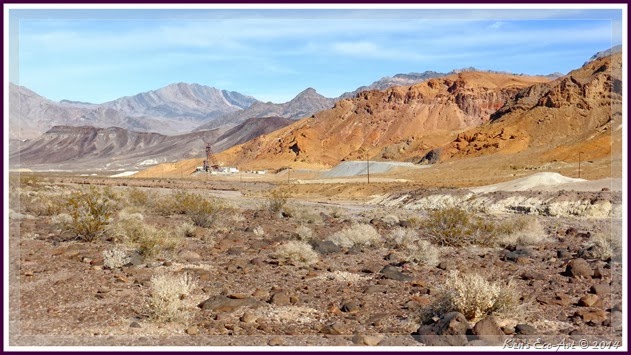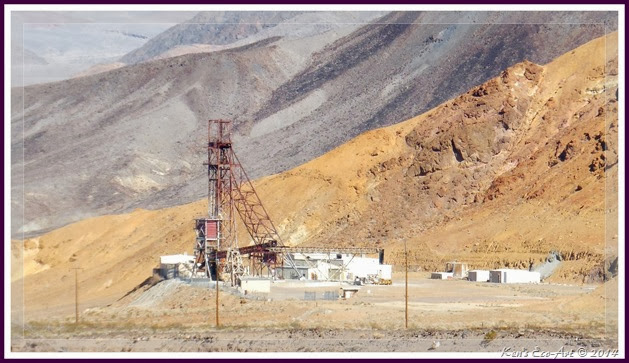{Click on an image to enlarge, then use the back button to return to this page}
This page last updated on 02097/2018
 |
| (Fig. 01) |
|
|
 |
| (Fig. 02) |
|
Understanding the Area: Furnace Creek Wash runs north through Green Water Valley, between the Black Mountains in the Amargosa Range to the west and the Green Water Range to the east, along what is known as Furnace Creek Wash Rd (a.k.a. Dante’s View Road), all the way to CA-190 (Fig. 02), whereupon it then crosses CA-190 and runs along the northeast side of the road down to Furnace Creek. The Billie Mine is about 2.4 miles south of CA-190 on the east side of the road. |
|
| Directions: From the Stratosphere Casino head southwest on S Las Vegas Blvd toward W Baltimore Ave. Travel 1.7 miles and turn right onto Spring Mountain Rd. Go .7 miles and turn left to merge onto I-15 South. Follow for 5.4 miles and take exit 33 to merge onto NV-160 W/Blue Diamond Rd/State Route 160 W toward Pahrump. Continue to follow NV-160 W/State Route 160 West for 55 miles In Pahrump, continue straight on Hwy. 160 through three stoplights then drive 3.1 miles. Turn left at Bell Vista Road and continue 25.5 miles to Death Valley Junction. Turn right and then immediately left on CA Hwy 190 and drive 26 miles and turn left onto Furnace Creek Wash Road. The Billie Mine is about 2.4 miles on the left. |
|
02/28/2014 Trip Notes: Though we drove by these areas on today's visit to the park, rain discourage us from doing and hiking and further exploration of the area.
01/27/2014 Trip Notes: While driving up Furnace Creek Wash Road to Dante’s View I stopped along the side of the road to take a few pictures of the Billie Borax Mine (Figs. 01 & 02). At the time we had no idea that we were looking at one of the largest Borax mines at Death Valley. Currently, I’m planning another trip here at the end of February. |
|
The Billie Mine: This site is located in the center of the main borate mining district of Death Valley, just outside of the boundary for Death Valley National Park (Fig. 02). The actual national park boundary runs through the wash along the east side of the road here, making both the Billie Mine site and the abandoned mining town of Ryan visible in the near distance to the south outside of the national park. Most of the borax minerals mined in Death Valley come from the (Pliocene) formations found at Furnace Creek. Here at the Billie mine, and previously at Ryan, these minerals were mined from shafts within this formation. West of the highway you can see a poor job of reclamation attempted to return the area to a natural condition after the open pit mining that took place here in the 1970’s. Looking beyond the Billie Mine to the Funeral Mountains, one can see a sequence of upper Precambrian to lower Paleozoic strata tilting eastward (Fig. 01).
During the years following the closing of the mines at Ryan, there was low borate activity in Death Valley until the Kern County Land Company became interested in borates, and started staking and drilling the Billie Mine claims in 1958. The Billie Mine, an underground borax mine along the road to Dante’s View operated for decades and by 2003 was the only active mining operation left in Death Valley National Park. The Billie Mine's headframe (Fig. 03) and waste dumps, across Furnace Creek Wash, are outside of the national park, but the ore deposit itself is within the park boundary, as much as 700 feet beneath the surface between its main shaft and Dante's View Road. The Billie deposit is much larger than the one that was mined at the nearby Boraxo Mine. With many deep shafts (some over 700 feet) and tunnels more than 1,600 feet long. As already noted, this mining operation actually goes under Furnace Creek Wash Road into the boundaries of Death Valley National Park. Specific minerals mined here included mostly Proberite, Ulexite and Colemanite. One of the main reasons the Billie Mine was allowed to tunnel under the national park at this location was because of the relatively rare form of Ulexite found in these deposits. The origin of these minerals is thought to be from hydrothermal fluids circulating through the Furnace Creek formation. Located about 2 miles north west of Ryan,opposite the Billie Mine is the open pit Boraxo Mine (Fig. 02) began operations during the early 70's. However, the scaring of the landscape (Fig. 04) brought a public outcry that led to greater protections of National Park Areas.
Congress passed the Mining in the Parks Act in 1976 which closed Death Valley National Monument to the filing of new mining claims, banned open-pit mining and required the National Park Service to examine the validity of thousands of pre-1976 mining claims. Mining was allowed to resume on a limited basis in 1980 with stricter environmental standards. Mine operators are required to get approval of a Plan of Operations which should mitigate damage to the environment.
Even though it was expected to be producing ore well into the twenty-first century, the mine was permanently closed in 2005, making it the last of Death Valley’s mine operations. The property has since been donated to the National Park Service. Plans are to use it for the interpretation of the park's mining history in conjunction with the proposed education center at Ryan. |
| |
 |
| (Fig. 03) |
|
|